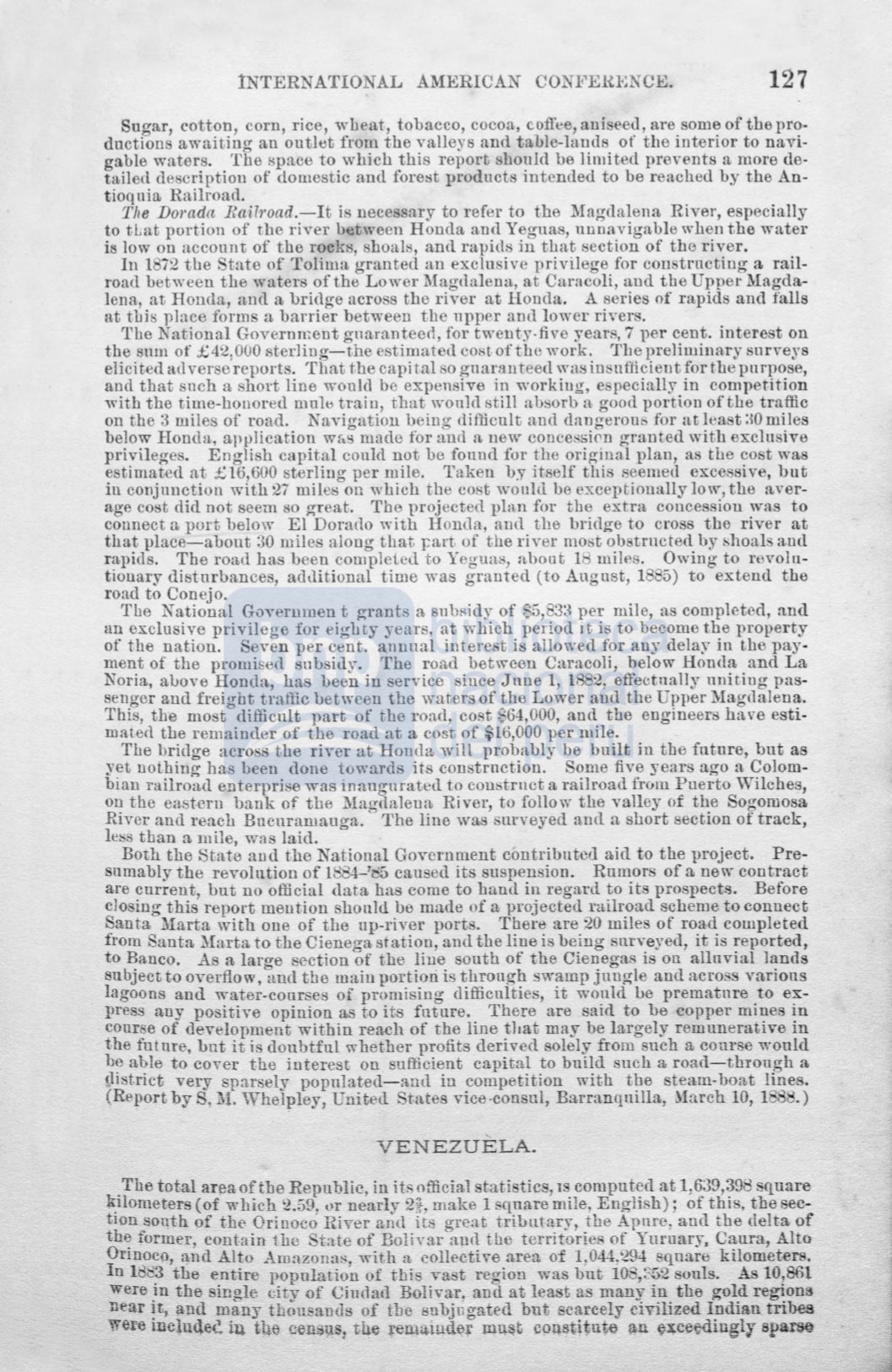

lNTERNATIONAL AMERICAN CONFEl l<:NCE.
127
Sugar, cotton, corn, rice, wbeat, tobacco, cocoa, co:ffee, aniseed, are sorne of tbe pro–
ductions awaiting an outlet from tbe valleys and table-la,nds of the interior to navi–
gable waters. The space to whicb tbis report should be limited prevents a more de–
tailed descriptiou of doruestic and forest products intended to be reached by the An–
tioquia Railroad.
1'he Dorada Rail?·oad.-lt
i · necessary to refer to the Magdalena River, especially
to tLat portion of the river between Honda and Yegua , unnavigable wben the water
is low ou account of the rocks, shoals, and rapids in that section of the river.
In 1 72 tbe State of Tolima granted an exclu ive privilege for constructing a rail–
road between the waters ofthe Lower Magdalena, at Caracoli, and tbe Upper Magda–
lena, at Ronda, anda bridge across the river at Honda. A series of rapids and falls
at tbis place forms a barrier between tbe 11pper and lower rivers.
The National Government guaranteerl, for twent.y-five year,
7
per cent. interest on
the stun of
1:42,000
sterling-the estimated co
t
ofthe work. Tbe preliminary snrveys
elicited atlversereports. That the capital o gnaranteed was insnfticientforthe pnrpose,
and that snch a short line would be expensive in workiug, e pecially in compet.ition
with tbe time-bouored mule traiu, that wouldstill absorba good portion ofthe traffic
on the
3
miles of road. Navigation being difficult ancl clangerous for
at
lea
t
:lO
miles
below Honda, application w&s made for anri
a
new conce ·si<'n granted with xclnsive
privileges. English capital could not be found for the original plan, as the cost was
estimated at
±:16,600
sterling per mile. Taken by itself this seemeu exce si ve, but
in conjuuction with
27
miles on which tbe cotit woulu be exceptionally low, the aver–
age cost did not seem so great. Tbe projected plan for tbe extnt concession was to
connect
:1
port below El Dorado with Honda, aud the bridge to cross tbe river at
that place-about
30
miles along that ¡:art of the river moot obstructecl by shoal ancl
rapids. The road has been comp1eied to
Yegua~;,
about 18 miles. Owing to revoln–
tionary clisturbances, additional time was granted (to Augnst,
1
5)
to exten
el
tbe
road to Conejo.
Tbe National Goveromen t grants a subRidy of
$5,
3~{
per mile, as comp1eted, and
an exclusive privilege for eigllty years, at which period it is to become the property
of tbe nation. Seven per cent. annual intercst is a11owed for auy delay in the pay–
ment of the proruised sub iuy. The road betwcen Caracoli, below Honda and La
Noria, above Honda, has been in service
iuce Jnne 1,
1882,
effectnally unitiug pas–
sengcr and freigbt traffic between the waters of the Lower allll the Upper Magr1alena.
This, tbe most clifficult part of the road, cost
.64,000,
ancl the engineers haYe esti–
matecl tbe remainder of the road ata cost of
$16,000
per mile.
The bridge acro s the river at Houlla will probably be buiU in tbe futnre, but as
yet uothing has been done towards its con trnction. Sorne five years ago a Colom–
bian railroad enterpri ·e was Inauo-nrated to con trnct a railroacl from Puerto Wilcbes,
ou
the easteru bank of the
l\1a~da1enn,
River, to follow the valley of tlle Sogomosa
River and reacb Bncurarua.uga.
~
'l'he line wa
urveyed an(l a short ection of track,
less than a mile, was laid.
Both the St:üe aud tbe National Govcrnment contributcu aid to the project. Pre–
snrnably the revolution of ltl84-'ti5 caused its suspension. Rurnors of a new contract
are current, but no official data has come to hand in regaru to its prospects. Before
closiug this report mention shonltl be made of a projected railroad scheme to connect
anta Marta with oue of the up-river ports. Tbere are
20
miles of roa-d completed
from Santa :Marta to the Cienega station, ancl the line is being snrveyed, it is reportecl,
to Banco. As a large section of the line south of the Cienegas is on allnvial lands
snbject to o-verflow,
<md
the m;tin portiori is throngh swamp jungle and acro s varions
lagoons and water-course of promising <lifficulties, it wonld l>e prematnre to ex–
press any positive opinion asto its fnture. There are said to be copper mines iu
conr ·e of development within reach of the line tltat may be largely remnnerative in
the future, but it is doubtful whetber profits derived solely from such a conrse would
b~
able to co>er the interest on sufficient capital to bnilcl such a road-
through
a
d1
t-rict very spar. ely popnlated- and in competition with tbe
team-boat lines.
(Report by S.
M.
Whelpley, Unitetl
tates vice-consnl, Barranqnilla, .\1arch
10,
18 ~
.)
VENE ZUELA.
_Tbe total areaoftbe Republic, in
it.
officia1 stati ties,
1
computed at 1,639,39 square
lr_Ilometers (of which 2.59, or nearly
2~,
make 1 qnaremile, Engli h); of thi , the ec–
tion south of the Orinoco Hiver
and
it
grea
t trib!ltary, tbe Apure, and tbe delta
of
tb~
former, contain tbc
tate of Bolívar au(l
tl.le tenitorie of Yuruary, Caura, Alto
Ormoco, and Alto •
mnzona)l,
with
~t
collective area of
1.04:1.~94
qnare kilometers.
In
lo
~
the entire popnlation of tbi
-vast region was but
10"',:352
sonls.
As
10 861
were
.m
the ingle citv of Ciudad Bolivar, and at least as
many
in tbe gold reg10ns
near
~t,
and many tllousands of tbe subjngated bnt carcely civilized Inclian tribea
were mcludec
iu
the cen¡;us
1
the
rem:.¡,wde¡·
must
constitu
e
a.n
~+ce
dingly
spa:rstl
















